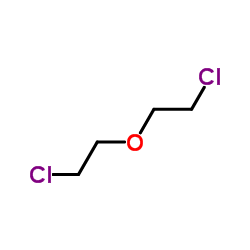Surface catalyzed Fenton treatment of bis(2-chloroethyl) ether and bis(2-chloroethoxy) methane.
Maria D M Mutuc, Nancy G Love, Peter J Vikesland
文献索引:Chemosphere 70(8) , 1390-8, (2008)
全文:HTML全文
摘要
This study examined the feasibility of using surface catalyzed Fenton treatment to remediate soil and groundwater contaminated by the chlorinated ethers, bis(2-chloroethyl) ether (BCEE) and bis(2-chloroethoxy) methane (BCEM). Parameters that affect the contaminant loss rate such as porewater pH, hydrogen peroxide concentration, and solid/water ratio were systematically evaluated. Batch reactors were set-up utilizing either contaminated or uncontaminated soil, obtained from an industrial site in Moss Point, MS, that was mixed with synthetic groundwater containing the contaminants of interest. The results show an increase in contaminant reduction with a decrease in pH, an increase in hydrogen peroxide concentration, or an increase in the solid/water ratio. For a similar set of conditions, contaminant reduction was greater for systems utilizing contaminated soil as compared to the systems containing uncontaminated soil. In addition, specific oxygen uptake rates (SOURs) were measured for biomass, collected from an activated sludge plant, exposed to different dilutions of untreated and surface catalyzed Fenton treated water to evaluate whether residual BCEE, BCEM, and their co-contaminants as well as their oxidation by-products were potentially inhibitory or can potentially serve as a substrate for the biomass. The measured SOURs show that the surface catalyzed Fenton treatment enhanced the biodegradability of the contaminated groundwater and served as a substrate for the biomass.
相关化合物
| 结构式 | 名称/CAS号 | 分子式 | 全部文献 |
|---|---|---|---|
 |
二氯乙基醚
CAS:111-44-4 |
C4H8Cl2O |
|
Carcinogenicity tests of certain environmental and industria...
1981-07-01 [J. Natl. Cancer Inst. 67(1) , 75-88, (1981)] |
|
Thiodiglycolic acid: a major metabolite of bis(2-chloroethyl...
1979-01-01 [Toxicol. Appl. Pharmacol. 47(1) , 23-34, (1979)] |
|
Bis(2-chloroethyl)ether.
1999-01-01 [IARC Monogr. Eval. Carcinog. Risks Hum. 71 Pt 3 , 1265-9, (1999)] |
|
[Medical topics: bischloromethyl ether and lung cancer].
1985-12-01 [Kango. 37(14) , 82, (1985)] |
|
Treatment of persistent organic compounds by integrated adva...
2009-01-01 [Water Res. 43(16) , 3910-21, (2009)] |